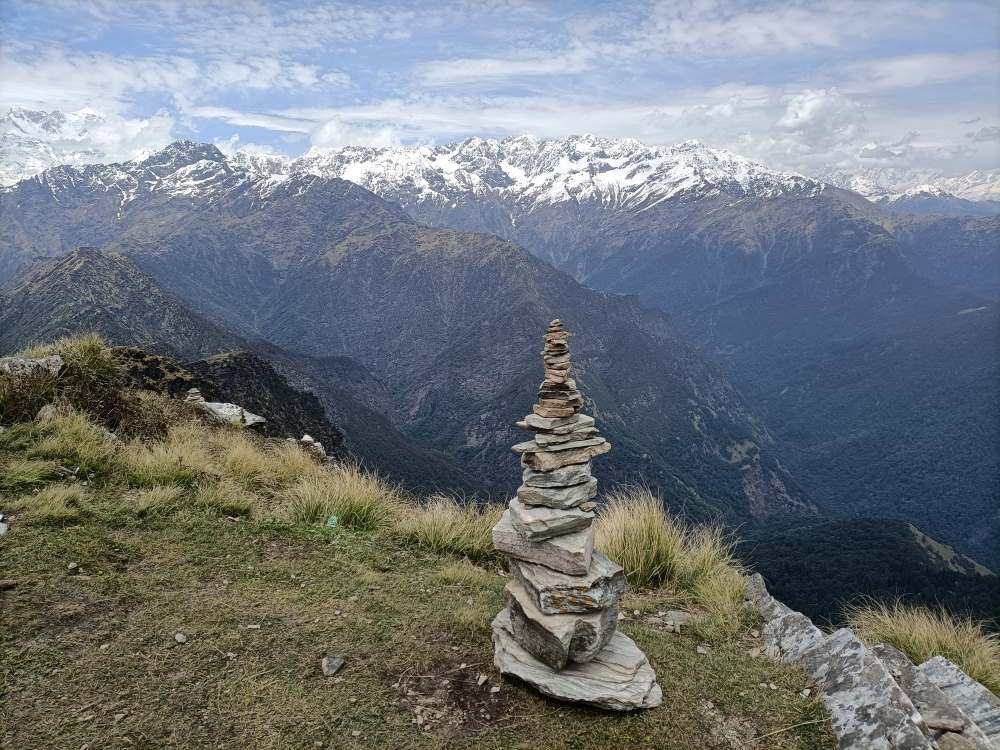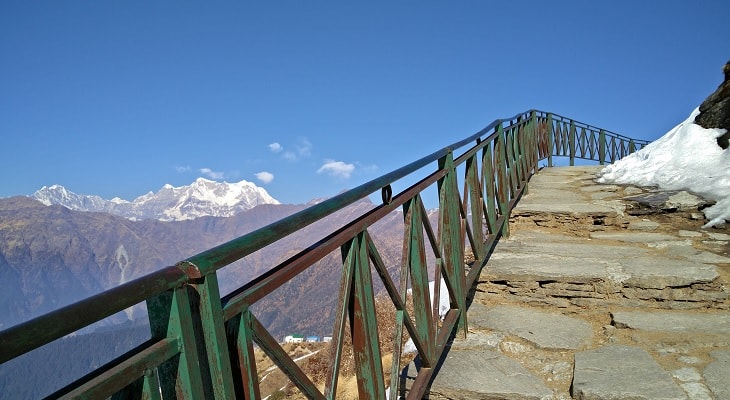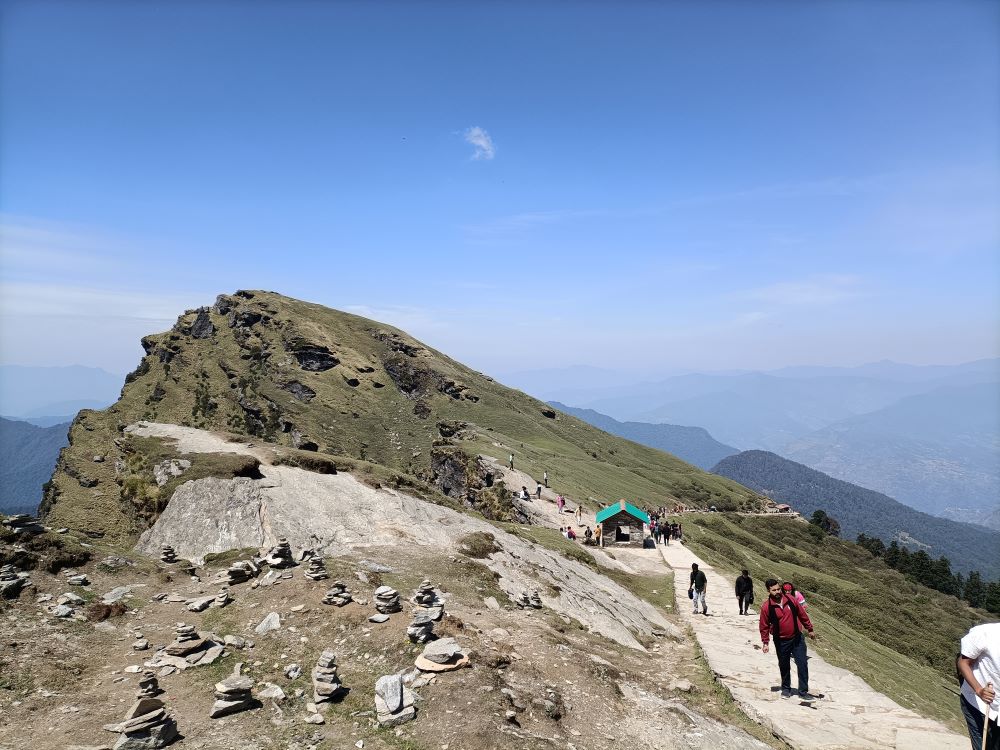Chopta Chandrashila Trek from Delhi: Your Scenic Journey to the Summit Skies
Published on June 18, 2025
Chopta chandrashila trek from delhi, If you're dreaming of standing above the clouds, surrounded by snow-capped Himalayan peaks, and soaking in divine peace—then the Chopta Chandrashila Trek from Delhi is your perfect escape. This journey combines nature, spirituality, and adventure into one unforgettable experience.
From Delhi’s buzzing streets to Chopta’s serene meadows, this trek is a refreshing journey into Uttarakhand’s unspoiled wilderness. Whether you're seeking a spiritual walk to the Tungnath Temple, the thrill of reaching the Chandrashila Summit, or a cozy nature getaway, our specially designed Chopta tour packages deliver it all.

Trek Timeline: Exploring Chopta, Tungnath & Chandrashila
Day 0: Departure from Delhi – Overnight Journey
10:00 PM: Depart from Delhi by AC Volvo bus or shared cab or tempo traveller towards Chopta.
Overnight: Onboard journey to Sari Village (approx. 12–14 hours).
Day 1: Arrival at Sari Village – Deoria Tal Trek & Bonfire Night
Morning: Reach Sari Village , check-in at cottages.
Afternoon: Begin trek to Deoria Tal (3 km, approx. 1.5 hrs one-way).
Enjoy scenic views of Himalayan peaks reflected in the crystal-clear lake.
Evening: Return to cottages, relax, and enjoy a bonfire & DJ night under the stars.
Stay: Overnight in cottages at Sari Village.
Day 2: Chopta – Tungnath Temple Trek to Chandrashila Summit
Early Morning: Drive to Chopta (approx. 1 hour).
Trek: Start the Tungnath Temple trek (3.5 km, 2–3 hours).
Visit Tungnath Temple (highest Shiva temple), then ascend to Chandrashila Peak (1 km further).
Breathtaking 360° views of Nanda Devi, Trishul, Kedar Dome, and more.
Afternoon: Return to Chopta for lunch.
Evening: Free time to explore local cafes or nature trails.
Stay: Overnight in cottages at Chopta.
Day 3: Explore Ukhimath & Dhari Devi – Return to Delhi
Morning: Visit Ukhimath (winter seat of Lord Kedarnath) and Dhari Devi Temple (on Alaknanda River).
Afternoon: Depart for Delhi via Devprayag.
Evening/Night: Stop for dinner en route.
Arrival: Reach Delhi by late night.

Stay Amid the Serenity: Accommodations in Chopta Chandrashila
When you embark on the Chopta Chandrashila trek, where you rest your head becomes part of your adventure. The region offers a range of accommodations that blend seamlessly with the natural surroundings—each offering warmth, comfort, and stunning views of the Himalayas.
Cozy Campsites in Nature’s Lap
Imagine waking up in a tent surrounded by deodar forests and the soft hum of the Himalayan breeze. Camps in Chopta provide exactly that—fresh air, starry skies, and a feeling of being close to nature. These tents range from basic alpine styles with shared washrooms to comfortable Swiss tents with attached facilities, soft bedding, and cozy blankets.
Best for: Adventure lovers, group travelers, and budget explorers
Vibe: Rustic charm + bonfire evenings
Himalayan Homestays with Local Warmth
Homestays in Chopta are a wonderful way to experience the warmth of mountain hospitality. Run by locals, these accommodations offer clean rooms, home-cooked meals, and heartwarming stories by the fire. Rooms usually come with basic facilities like hot water, clean bedding, and mountain views that money can’t buy.
Best for: Solo travelers, couples, and culture lovers
Vibe: Peaceful, personal, and locally rich
Trekking Huts & Trailside Stays
For those looking to stay closer to the trekking trail—especially near Tungnath or the base of Chandrashila—there are simple trekking huts and shared lodges available. These offer just the essentials: a place to sleep, protection from the cold, and sometimes even a magical sunrise view right from your doorstep.
Best for: Trekkers looking to start early, budget backpackers
Vibe: No-frills, practical, high on location
Eco-Lodges & Nature Retreats
Want a bit of comfort with your Himalayan escape? Some eco-lodges near Chopta offer private cottages, delicious organic meals, and sustainable living—all without disturbing the natural balance. Surrounded by wildflowers in summer or snow in winter, these retreats provide a peaceful space to unwind after a long day of trekking.
Best for: Families, couples, luxury nature seekers
Vibe: Quiet, comfortable, and eco-conscious
Tips Before You Book
-
Book early during peak seasons (April–June and Dec–Feb), as accommodations fill fast.
-
Check for heating if visiting in winter—some camps and rooms provide heaters or hot water bottles.
-
Choose your location wisely—staying near the starting point of the Tungnath temple trek can give you a head start.
-
Ask about meals—many stays include simple, hearty local food in their packages.

Pack Smart, Trek Free: What to Carry & What to Skip for Your Chopta Tour
Embarking on the Chopta tour, especially for the Chopta Chandrashila trek or Tungnath temple trek, means stepping into nature’s peaceful playground. But the key to enjoying every moment of this Himalayan escape? Packing smart! Here's a complete list of what to pack and what to leave behind.
What to Pack for Your Chopta Tour
Whether you’re trekking to Chandrashila or exploring the meadows of Chopta, these essentials will keep you safe, warm, and comfortable:
Clothing Essentials
-
Warm layers: Fleece jacket, thermal innerwear, and a down/insulated jacket (especially for early mornings and evenings)
-
Waterproof windcheater or raincoat: Sudden drizzles are common
-
Trekking pants: Quick-dry and stretchable
-
Full-sleeve T-shirts: Protect from sun and insects
-
Woolen cap, gloves & socks: Absolute must in colder months
-
Comfortable trekking shoes: With good grip and ankle support
-
Extra pair of socks and innerwear
Personal Gear
-
Backpack (30–50L): With rain cover
-
Daypack (small bag): For short treks and carrying essentials
-
Reusable water bottle or hydration pack
-
Sunglasses & sunscreen: To fight high-altitude sun
-
Torch/headlamp: Power cuts are common at night
-
Trekking pole (optional but helpful on steep climbs)
Toiletries & First Aid
-
Toothbrush, small towel, biodegradable soap
-
Lip balm, moisturizer, hand sanitizer
-
Basic medicines: For headache, fever, cold, body ache, altitude sickness
-
Personal sanitary items
-
Band-aids, antiseptic cream, and cotton
Electronics & Extras
-
Power bank (electricity can be unreliable)
-
Camera/GoPro: For capturing stunning views
-
ID card (Aadhaar/Passport): For check-ins and permits
-
Snacks: Energy bars, dry fruits, chocolates
What to Skip for Your Chopta Tour
The lighter your bag, the happier your trek. Here’s what you don’t need on your Chopta adventure:
-
Heavy luggage or trolleys – Difficult to carry on rough mountain paths
-
Excessive beauty products – Keep it minimal and natural
-
High heels or sandals – Not suitable for uneven terrain
-
Expensive jewelry or gadgets – Not worth the risk in remote areas
-
Too many clothes – Pack versatile and layer-friendly options instead
-
Plastic waste – Carry reusable items and respect nature

Seasons of Serenity: Weather on the Chopta Chandrashila Trek
The Chopta Chandrashila trek, nestled in the lap of the Garhwal Himalayas, is a journey where the weather adds both beauty and challenge. From misty mornings and snowy summits to blooming meadows under a crisp sky—each season brings a different charm. Knowing the weather is key to planning the perfect trek.
Spring (March to April)
Weather: Cool and refreshing
Temperature: 5°C to 15°C
Experience: This is one of the most pleasant times to trek. The forests come alive with rhododendron (buransh) blooms, and snow can still be seen at the higher altitudes. Clear skies offer breathtaking views of Nanda Devi and Chaukhamba peaks.
Ideal for: Nature lovers, first-time trekkers, photography enthusiasts
Summer (May to June)
Weather: Mild days and cool nights
Temperature: 8°C to 18°C
Experience: Days are warm and perfect for trekking in light layers. The meadows are lush green, and trails are dry and safe. This is the peak trekking season, and the views are simply stunning.
Ideal for: Family trips, couples, and easy trekking
Monsoon (July to September)
Weather: Wet, misty, and unpredictable
Temperature: 10°C to 17°C
Experience: The region receives heavy rainfall during these months, which can make trails slippery and risky. Landslides and cloud cover may affect travel and visibility. Treks are not recommended during monsoon.
Ideal for: Offbeat travelers with proper rain gear (though not advisable)
Autumn (October to November)
Weather: Crisp and clear
Temperature: 2°C to 14°C
Experience: One of the best times to do the Chopta Chandrashila trek. Skies are blue, the air is fresh, and the mountains stand proudly without haze. This is when you can truly see the snow-covered Himalayan giants in full glory.
Ideal for: Serious trekkers, photographers, adventure seekers
Winter (December to February)
Weather: Cold, snowy, and magical
Temperature: -5°C to 10°C
Experience: The trek turns into a snow trek! Tungnath Temple is usually snow-covered, and Chandrashila summit offers dramatic panoramic views. Trails are icy but enchanting.
Ideal for: Snow lovers, experienced trekkers, thrill-seekers

Flora & Fauna in Chopta: Nature’s Secret Symphony
Nestled in the lap of the Garhwal Himalayas, Chopta is not just a trekking paradise—it’s a living, breathing canvas of biodiversity. From vibrant wildflowers to elusive Himalayan wildlife, this region is a dream for nature lovers, wildlife photographers, and eco-tourists. The journey to Tungnath Temple and Chandrashila Summit becomes even more magical when you notice the natural world around you.
Flora: A Blooming Himalayan Garden
Chopta is part of the Kedarnath Wildlife Sanctuary, which boasts lush alpine meadows, dense forests, and rare high-altitude plants. Here's what to expect:
Rhododendron (Buransh) Forests
During spring (March–April), Chopta bursts into a riot of colors with blooming Buransh flowers, the state flower of Uttarakhand. These bright red and pink blossoms paint the forest like a fairytale.
Deodar, Oak, and Pine Trees
As you trek uphill, the forests shift from oak and pine to towering deodar trees. Their scent fills the air and provides shelter to a wide variety of birds and animals.
Alpine Meadows (Bugyals)
Above the tree line, you’ll step into vast meadows filled with wildflowers in summer. These bugyals are perfect picnic spots—and photography heaven!
Rare Himalayan Herbs
If you're a botany enthusiast, look closely—Chopta's high-altitude zone is home to many medicinal plants and rare herbs used in Ayurveda.

Fauna: Wildlife That Calls Chopta Home
The forests and meadows of Chopta are not just beautiful—they’re alive. As you trek, keep your eyes and ears open for some of these wild residents:
Musk Deer & Barking Deer
These shy, beautiful animals roam the denser parts of the forest. Spotting them is rare—but magical when it happens.
Himalayan Black Bear
A rare sight, the black bear inhabits the deeper zones of the Kedarnath sanctuary. They are usually active at dusk and dawn.
Leopard
Though elusive and rarely seen, leopards are known to inhabit the region’s dense forest areas.
Himalayan Monal (State Bird of Uttarakhand)
One of the most colorful and prized sightings in Chopta! The Monal flaunts metallic blue, green, and orange feathers and is often spotted in the early mornings.
Other Animals & Birds
-
Langurs & red foxes
-
Snowcocks and woodpeckers
-
Eagles, hawks, and Himalayan vultures
-
Butterflies, wild bees, and Himalayan weasels

Step Gently, Look Closely, Feel Deeply
The flora and fauna of Chopta are not just a backdrop—they are part of the soul of this place. Whether you’re here for the Chopta Tungnath trek, the Chandrashila summit, or a peaceful retreat, take a moment to pause, observe, and appreciate nature’s quiet brilliance.
The Final Footprints: Let Chopta Etch Its Magic in Your Soul
Chopta is not just a destination—it’s an experience carved in silence, snow, sunshine, and starlight. Whether you’re trekking to the sacred Tungnath Temple, conquering the heights of Chandrashila summit trek, or simply watching the clouds roll by from a meadow, this place has a way of speaking to your heart.
From the vibrant flora and fauna, the ever-changing weather, soulful homestays, and thrilling adventures, every step in Chopta whispers stories of peace, wonder, and connection. And as your journey ends, Chopta doesn't say goodbye—it lingers in your spirit, calling you back again and again.
So pack your bag, breathe in the mountain air, and let the Chopta tour be your escape into calm, clarity, and pure Himalayan magic.
Frequently Asked Questions:
1. What is included in the Chopta tour package?
Transport, stay, meals, trek guide, and bonfire (inclusions may vary depending on the package).
2. What is the best time to visit Chopta?
March to June and October to December are the best months for pleasant weather and scenic views.
3. How difficult is the Chopta Chandrashila trek?
It’s an easy to moderate trek, suitable for beginners with basic fitness.
4. What’s the weather like in Chopta?
Cool in summer (8°C–18°C), snowy in winter (-5°C–10°C), and wet during the monsoon.
5. Are accommodations available in Chopta?
Yes, options include homestays, cottages, camps, and budget hotels with basic facilities.
6. What should I pack for the Chopta tour?
Warm clothes, trekking shoes, rain gear, flashlight, water bottle, ID proof, and basic medicines.
7. Can couples book a Chopta tour package?
Yes, there are dedicated Chopta tour packages for couples that include private stays and cozy experiences.
8. Is there snowfall in Chopta?
Yes, snowfall usually occurs from December to February, offering beautiful snow trek experiences.
9. How far is Chopta from Delhi?
Chopta is around 450 km from Delhi and takes approximately 10–12 hours to reach by road.
10. Is the Tungnath Temple open year-round?
No, it remains open from late April to early November and closes during heavy snowfall in winter.


.jpg)
